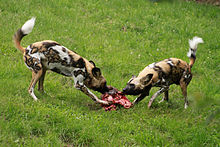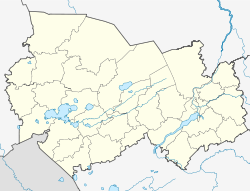리카온 (유전자)
Lycaon (genus)| 리카온 | |
|---|---|
 | |
| 아프리카 들개 | |
| 과학적 분류 | |
| 왕국: | 애니멀리아 |
| 망울: | 코다타 |
| 등급: | 포유류 |
| 순서: | 육식류 |
| 가족: | 개과 |
| Subfamily: | 카니나아과 |
| 부족: | 카니니 |
| 속: | 리카온 브룩크스, 1827년 |
| 종 | |
리카온은 아프리카 야생견(Lycaon pictus)과 멸종된 리카온 세코웨이를 포함하는 카니드의 속이다.
분류 법은
이 초음속과 고음속은 전각의 부속 쿠스로 구별된다. 그것은 플리오-플리스토세 기간 동안 늑대와 같은 캐니드 혈통으로부터 파생되었다. 이후 라이카온은 몸이 가벼워지고 테트라다틸이 되었으나 과음성으로 남아 있었다. 리카온 세코웨이는 남아프리카 공화국의 플리오세네와 플레스토세네에서 알려져 있으며 덜 주관적이었다.[1]
일부 연구자들은 멸종된 카니스 하위 유전자인 제노키온을 라이카온과 쿠온 모두의 조상이라고 생각한다.[2][3]: p149
Other researchers propose that the extinct Canis (Xenocyon) falconeri and Canis (Xenocyon) lycaonoides should be classified under genus Lycaon, to give the descent of 3 chronospecies: L. falconeri in the Late Pliocene of Eurasia → L. lycaonoides in the Early Pleistocene and the beginning of the Middle Pleistocene of Eurasia and Africa → L. pictus 중후기 플리스토센과 오늘날 현존하는 아프리카 후손이다.[4]
참고 항목
- 늑대로 변신한 그리스 신화의 인물 아르카디아의 리카온
참조
- ^ Hartstone-Rose, A.; Werdelin, L.; De Ruiter, D. J.; Berger, L. R.; Churchill, S. E. (2010). "The Plio-Pleistocene Ancestor of Wild Dogs, Lycaon sekowei n. sp". Journal of Paleontology. 84 (2): 299–308. doi:10.1666/09-124.1.
- ^ Cherin, Marco; Bertè, Davide F.; Rook, Lorenzo; Sardella, Raffaele (2013). "Re-Defining Canis etruscus (Canidae, Mammalia): A New Look into the Evolutionary History of Early Pleistocene Dogs Resulting from the Outstanding Fossil Record from Pantalla (Italy)". Journal of Mammalian Evolution. 21: 95. doi:10.1007/s10914-013-9227-4.
- ^ 왕, 샤오밍, 테드포드, 리처드 H.; 개: 그들의 화석 친척들과 진화 역사. 뉴욕: 컬럼비아 대학 출판부, 2008.
- ^ Martínez-Navarro, B. & L. Rook (2003). "Gradual evolution in the African hunting dog lineage: systematic implications". Comptes Rendus Palevol. 2 (#8): 695–702. doi:10.1016/j.crpv.2003.06.002.
| 위키피아는 리카온과 관련된 정보를 가지고 있다. |
| 위키미디어 커먼즈에는 라이카온(genus)과 관련된 미디어가 있다. |


